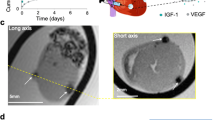Abstract
Vascular endothelial growth factor (VEGF) plays a pivotal role in angiogenesis in an infarcted myocardium. The purpose of the current investigation was to validate whether a radiolabeled VEGF delivery system can be effectively monitored in vivo, and to ascertain whether the growth factor induces an angiogenic effect to facilitate recovery from infarct conditions in rodent myocardial infarction (MI) models. Rat MI models were divided into three groups, one with left anterior descending coronary artery (LAD) ligation with no injection (the control group), one with LAD ligation and I-131 VEGF injection (the VEGF group), and one with LAD ligation and I-131 VEGF-loaded chitosan injection (the VIC group). On day 7 after injection, autoradiography imaging was performed, followed by semiquantitative and histopathologic analyses. In semi-quantitative analysis, the mean anterior-to-inferior wall ratio of the VIC group was significantly higher than those of the control and VEGF groups (p<0.05). Histopathologic experiments revealed a marked increase in microvascular density in the VIC group compared to those of the control and VEGF groups (p<0.05). Intramyocardially injected VIC was not only effectively monitored in vivo, but also stimulated therapeutic angiogenesis in the infarcted myocardium. Our findings support that the developed VIC is a novel theranostic tool to improve myocardial perfusion following myocardial infarction.

Similar content being viewed by others
References
S. Fukuda, S. Yoshii, S. Kaga, M. Matsumoto, K. Kugiyama, and N. Maulik, Mol. Cell. Biochem., 264, 143 (2004).
G. D. Yancopoulos, S. Davis, N. W. Gale, J. S. Rudge, S. J. Wiegand, and J. Holash, Nature, 407, 242 (2000).
K. Harada, M. Friedman, J. J. Lopez, S. Y. Wang, J. Li, P. V. Prasad, J. D. Pearlman, E. R. Edelman, F. W. Sellke, and M. Simons, Am. J. Physiol., 270, H1791 (1996).
T. D. Henry, B. H. Annex, G. R. McKendall, M. A. Azrin, J. J. Lopez, F. J. Giordano, P. K. Shah, J. T. Willerson, R. L. Benza, D. S. Berman, C. M. Gibson, A. Bajamonde, A. C. Rundle, J. Fine, and E. R. McCluskey, Circulation, 107, 1359 (2003).
G. C. Hughes, S. S. Biswas, B. Yin, R. E. Coleman, T. R. DeGrado, C. K. Landolfo, J. E. Lowe, B. H. Annex, and K. P. Landolfo, Ann. Thorac. Surg., 77, 812 (2004).
M. D. Hariawala, J. R. Horowitz, D. Esakof, D. D. Sheriff, D. H. Walter, B. Keyt, J. M. Isner, and J. F. Symes, J. Surg. Res., 63, 77 (1996).
R. J. Lee, M. L. Springer, W. E. Blanco-Bose, R. Shaw, P. C. Ursell, and H. M. Blau, Circulation, 102, 898 (2000).
R. Yang, G. R. Thomas, S. Bunting, A. Ko, N. Ferrara, B. Keyt, J. Ross, and H. Jin, J. Cardiovasc. Pharmacol., 27, 838 (1996).
T. Kean and M. Thanou, Adv. Drug Deliv. Rev., 62, 3 (2010).
J. J. Wang, Z. W. Zeng, R. Z. Xiao, T. Xie, G. L. Zhou, X. R. Zhan, and S. L. Wang, Int. J. Nanomedicine, 6, 765 (2011).
C. Kuntner, T. Wanek, M. Hoffer, D. Dangl, M. Hornof, H. Kvaternik, and O. Langer, Mol. Imaging Biol., 13, 222 (2011).
L. D. D’Andrea, A. Del Gatto, L. De Rosa, A. Romanelli, and C. Pedone, Curr. Pharm. Design, 15, 2414 (2009).
S. B. Freedman and J. M. Isner, Ann. Intern. Med., 136, 54 (2002).
A. Helisch and W. Schaper, Z. Kardiol., 89, 239 (2000).
R. Kornowski, S. Fuchs, M. B. Leon, and S. E. Epstein, Circulation, 101, 454 (2000).
R. J. Laham, L. Garcia, D. S. Baim, M. Post, and M. Simons, Curr. Interv. Cardiol. Rep., 1, 228 (1999).
Y. S. Yoon, I. A. Johnson, J. S. Park, L. Diaz, and D. W. Losordo, Mol. Cell. Biochem., 264, 63 (2004).
J. S. Kwon, I. K. Park, A. S. Cho, S. M. Shin, M. H. Hong, S. Y. Jeong, Y. S. Kim, J. J. Min, M. H. Jeong, W. J. Kim, S. Jo, S. H. Pun, J. G. Cho, J. C. Park, J. C. Kang, and Y. Ahn, J. Control. Release, 138, 168 (2009).
E. A. Silva and D. J. Mooney, J. Thromb. Haemost., 5, 590 (2007).
J. Wu, F. Zeng, X. P. Huang, J. C. Chung, F. Konecny, R. D. Weisel, and R. K. Li, Biomaterials, 32, 579 (2011).
J. Zhang, L. Ding, Y. Zhao, W. Sun, B. Chen, H. Lin, X. Wang, L. Zhang, B. Xu, and J. Dai, Circulation, 119, 1776 (2009).
F. Q. Hu, X. L. Wu, Y. Z. Du, J. You, and H. Yuan, Eur. J. Pharm. Biopharm., 69, 117 (2008).
C. M. Lee, D. Jang, J. Kim, S. J. Cheong, E. M. Kim, M. H. Jeong, S. H. Kim, D. W. Kim, S. T. Lim, M. H. Sohn, Y. Y. Jeong, and H. J. Jeong, Bioconjug. Chem., 22, 186 (2011).
J. Zhang, X. G. Chen, W. B. Peng, and C. S. Liu, Nanomedicine, 4, 208 (2008).
Author information
Authors and Affiliations
Corresponding author
Additional information
Dr. Kim and Dr. Lee equally contributed in this study.
Rights and permissions
About this article
Cite this article
Kim, DW., Lee, CM., Kim, NH. et al. Radiolabeled chitosan hydrogel containing VEGF enhances angiogenesis in a rodent model of acute myocardial infarction. Macromol. Res. 22, 272–278 (2014). https://doi.org/10.1007/s13233-014-2036-7
Received:
Revised:
Accepted:
Published:
Issue Date:
DOI: https://doi.org/10.1007/s13233-014-2036-7




